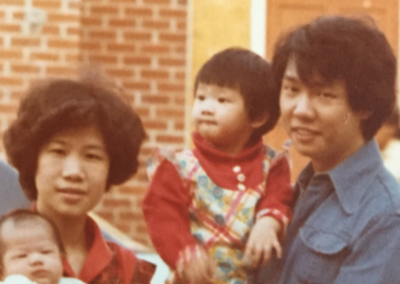Rankings vs. Reality: How Massachusetts is Leading on Health Equity

Massachusetts ranks as the second healthiest state in the nation (behind only Vermont) and boasts the lowest uninsured rate in the country – 2.7% compared to 8.7% nationally. Many of the state’s healthcare and public health initiatives – from addiction to mental health to vaping also serve as models for the rest of the country.
Still, there remains a 30-year gap in life expectancy from one neighborhood to the next. Why are black mothers far more likely to die in childbirth in Massachusetts hospitals than white mothers? Why are we last in the nation in ensuring residents aged 65+ and living alone have enough income to cover essentials like housing, food, healthcare, transportation, and everyday supplies? And what is Massachusetts doing about it?
These questions were the focus of a conversation among Dr. Monica Bharel, Dr. Thea James, Dr. Asaf Bitton and Lisa O’Connor at the Massachusetts Health Leads Advisory Council’s recent panel discussion, “Health Equity Outlook 2020: A Conversation about Massachusetts’ Most Pressing Health Equity Challenges.”
While the challenges are many, addressing health equity in Massachusetts is a clear priority – and innovation, collaboration, and action in this area continues to grow. Here’s what these three healthcare and public health leaders had to say about recent key milestones and where to focus in 2020 and beyond.
“Data is at the heart of how we target resources toward stubborn, persistent inequities.”
Monica Bharel, MD, MPH, Commissioner, Massachusetts Department of Public Health
The term “social determinants of health” is heard now more than ever. While so many of us in the field have been actively working to address social determinants for a long time, today it is finally elevated to a level where we are now evaluating what I see as the most critical piece – where and how resources that impact our health are distributed. The differences between who have access to essentials like safe housing and healthy food impact us all.
Today, the Massachusetts Department of Public Health is targeting resources toward the underlying causes of the most stubborn, persistent inequities – and data collection and analysis are at the heart of how we do it. For the first time in Massachusetts, we analyzed 30 data sets bringing together individual-level data from across government to examine prescriptions, drug treatment visits, hospital, and emergency room visits, ambulance runs, insurance claims and opioid-related deaths. This not only enables us to target collective resources to the places and people that need it most – it also allows us to adjust quickly as needed if an effort isn’t working.
The only way we will see the change we want to see is if all organizations across the state exercise their particular lever of influence to work against disparities. Our organization did this in 2017 when we redefined the state’s Community Benefit Guidelines so those investments are now required to address the upstream policies and programs at the root of so many health concerns. When we all use our levers of influence and work together, we can see the data and the resources start to shift to the right places.
“Do we want charity, or equity? One will change nothing. It might prevent people from drowning, but they won’t swim.”
Thea James, MD, Vice President of Mission & Associate Chief Medical Officer, Boston Medical Center
When people have limited resources, healthcare becomes secondary to survival. They will continue to be forced to make tough decisions between food, copayments or transportation. Doctors continue to chase disease, while patients are chasing life – and when those two things are competing, change doesn’t stand a chance.
Over the course of my career, when I’ve come into tragic situations, I ask people: what would it take for this to never happen again? We first have to understand history – i.e. the way the New Deal and redlining in one decade left millions of people of color out of pathways to wealth, and how we missed our opportunity to create public housing as a transient step, not a permanent solution. We need to understand how we have created two socioeconomic groups in this state – and remember these lessons as we create new systems and remove the structural barriers to enable people to thrive.
We also have to shift our mindsets about what is possible to achieve. Do we want charity or equity? One will change nothing. It might prevent people from drowning, but they won’t swim. We need to stop viewing social determinants of health or health equity as “programs” or “initiatives,” but as the norm.
Among many other efforts,BMC has committed to rebuilding eight acres of blight across the city with 320 units of affordable housing. The labor is sourced from the community, and we incented a grocery store to set up in the area with a no-interest loan. And for the first time last year, Boston hospitals conducted their community health needs assessment (CHNA) together. We are shifting the mindset, breaking down structures and doing it in collaboration.
“Health equity is at the root of our ability to build a high functioning society where everyone flourishes.”
Asaf Bitton, MD, MPH, Executive Director, Ariadne Labs
Charles Dickens would describe health in Massachusetts as, “It was the best of times, it was the worst of times.” Today, in the Back Bay neighborhood of Boston, life expectancy is over 90. Two miles away in Roxbury, life expectancy is in the mid-60s – on par with that of middle-income countries such as India and Ghana. That’s a 30-year gap in our own city that boasts some of the best health systems in the country.
We can consider the value of addressing health equity from a number of different angles. There’s the clinical case – and beyond my personal experience, volumes of research show that the jury is no longer out on how social determinants impact health at every turn. There’s the public health case – consider the emotional, societal, and financial toll we’re experiencing with the opioid crisis alone, not to mention so many other examples rooted in social, racial, and economic inequity. And there is the ethical case that ignoring these factors that impact health more than almost any other factor is politically and socially irresponsible. How a society treats its poorest, oldest, most infirm, and most marginalized members is a litmus test on the moral health of a society as a whole.
What’s been less discussed is the social and business case – and the reality that we will not make any leaps in health without major social and environmental investments to accompany our public health initiatives. Addressing health equity actually means building a high functioning society where everyone flourishes. The opportunity lies in approaching health challenges, not in isolation of other systemic issues, but in collaboration – and if we do, we will see the dividends in increasing human capacity as a whole. The investments we can make in transportation, food, housing, childcare, and effective social services pay dividends not only in health but also across other many other areas within our economy. An equitably healthy community is made up of a healthy workforce that can drive innovation, economic success, and vibrancy. The opposite is also true – we can’t maintain our gains as a city and a state if we allow health and economic inequities to stand.
Every organization needs to consider the opportunity to connect across sectors to build health equity – and ultimately, human capacity. It’s not just the right thing to do. It’s the thing we need to do.
Be the first to hear about Heath Leads learning events and panel discussions! Sign up for our newsletter here.




